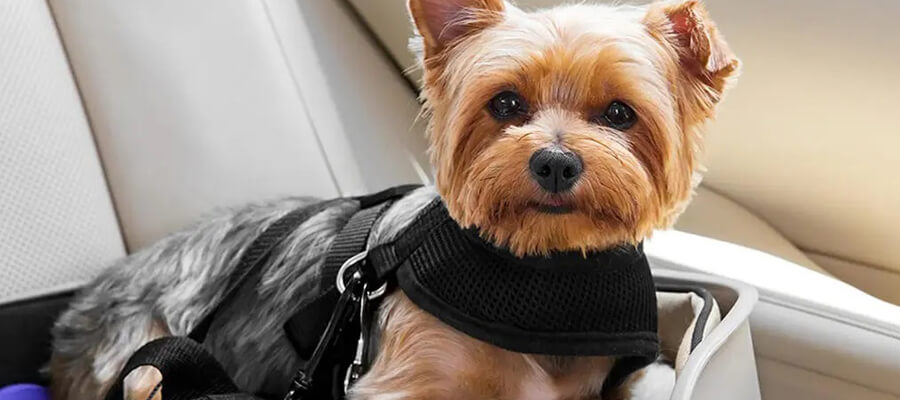
How to Handle Your Dog’s Anxiety When Traveling
Handle Your Dog’s Anxiety When Traveling
Traveling with your dog can be a joyful experience, but for many dogs, the excitement of a new environment can also lead to anxiety. Whether you're heading on a road trip, flying across the country, or simply visiting a new park, it's essential to ensure that your furry friend feels safe and comfortable. In this guide, we'll explore effective strategies to manage your dog's anxiety during travel, helping both of you enjoy the journey together.
1. Understanding Dog Anxiety
Dog anxiety can manifest in various ways, including:
- Whining or barking
- Pacing or restlessness
- Excessive panting or drooling
- Destructive behavior
- Hiding or seeking comfort from you
Recognizing these signs is crucial for addressing your dog's anxiety effectively. Understanding the triggers—such as loud noises, unfamiliar environments, or prolonged confinement—can help you prepare your dog for a smoother travel experience.
2. Preparation Before the Trip
Essentials for Your Newly Adopted Pet
Welcoming a shelter pet into your life is a beautiful journey. Here are some handpicked items to help your new friend feel safe, loved, and right at home:
Taking steps to prepare your dog can significantly reduce anxiety during travel. Here are some essential tips:
1. Get Your Dog Accustomed to the Carrier or Crate
- If you're traveling by air or using a crate, familiarize your dog with the carrier before the trip. Allow them to explore it, providing treats and praise to create positive associations.
2. Maintain a Routine
- Keep your dog’s feeding, walking, and playtime routines as consistent as possible leading up to the trip. A stable routine can help alleviate anxiety by providing a sense of familiarity.
3. Visit the Vet
- Schedule a vet appointment to ensure your dog is healthy and up-to-date on vaccinations. Discuss any anxiety issues and ask if anti-anxiety medications or supplements are appropriate for your dog.
3. During the Journey
While traveling, you can take specific actions to help manage your dog’s anxiety:
1. Create a Comfortable Environment
- Ensure your dog has a comfortable space in the car or crate. Use familiar bedding or toys to make the area feel safe and inviting. If traveling by car, consider using a dog seatbelt or carrier for safety.
2. Use Calming Aids
- Consider natural calming aids such as pheromone sprays, calming collars, or anxiety wraps designed to provide comfort during travel. There are also various supplements available that can help reduce anxiety.
3. Keep Them Engaged
- Bring along interactive toys or chew items to keep your dog occupied during the journey. Mental stimulation can help distract them from their anxiety.
4. Regular Breaks
- If you're on a long road trip, make regular stops to let your dog stretch their legs, relieve themselves, and explore their surroundings. This can help reduce anxiety caused by being confined for extended periods.
4. Post-Travel Care
After your trip, it’s important to help your dog readjust to their home environment:
1. Provide a Calm Space
- Once you arrive at your destination, set up a quiet area for your dog where they can relax away from noise and distractions. Familiar items from home can help ease their transition.
2. Monitor Behavior
- Keep an eye on your dog’s behavior after traveling. If they exhibit signs of lingering anxiety, consult your vet for additional support or behavioral strategies.
3. Reinforce Positive Experiences
- Encourage positive associations with travel by rewarding your dog for calm behavior and engaging in fun activities during your trips. This can help reduce anxiety over time.
Conclusion
Traveling with your dog can be a rewarding experience, but it requires careful planning and consideration for your furry friend’s comfort and well-being. By understanding your dog’s anxiety triggers, preparing in advance, and implementing calming strategies during travel, you can ensure a smoother and more enjoyable journey. Remember, patience and positive reinforcement are key to helping your dog feel secure and relaxed, allowing both of you to create wonderful memories on your adventures together.
Affiliate Products
We may earn a small commission when you shop through our links — it helps us keep sharing love and care for every dog out there, at no extra cost to you.
Up to 75% Discount

Dog Collar with Health Monitoring
BUY NOW »
Up to 55% Discount

Luxury Faux Furhuge Napping Bed
BUY NOW »

